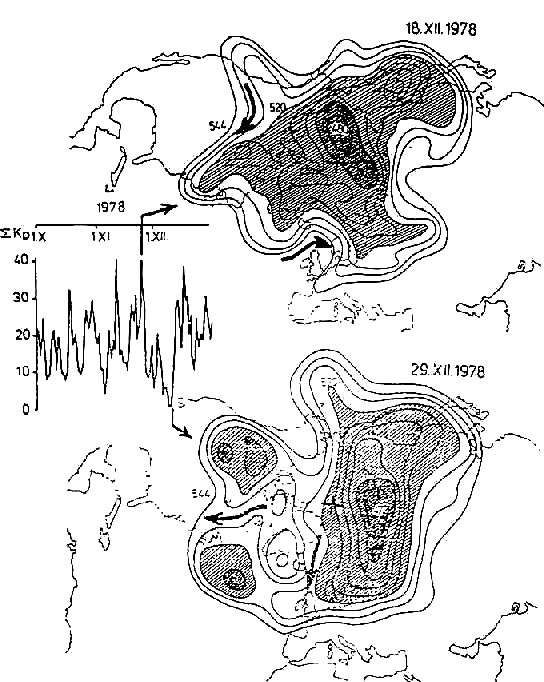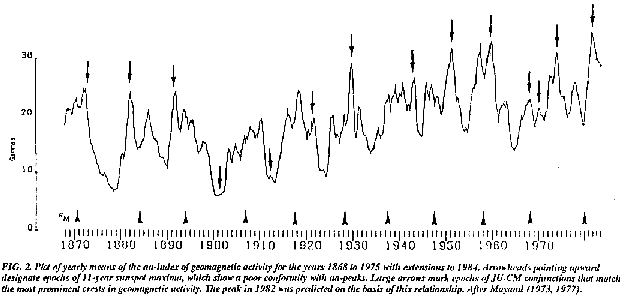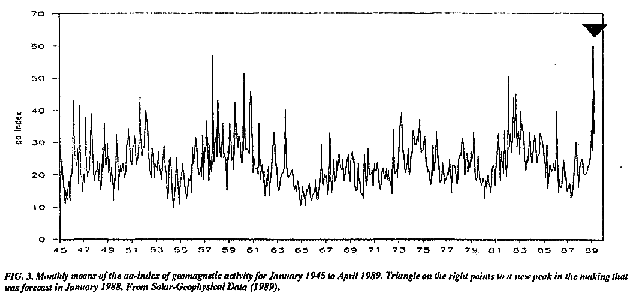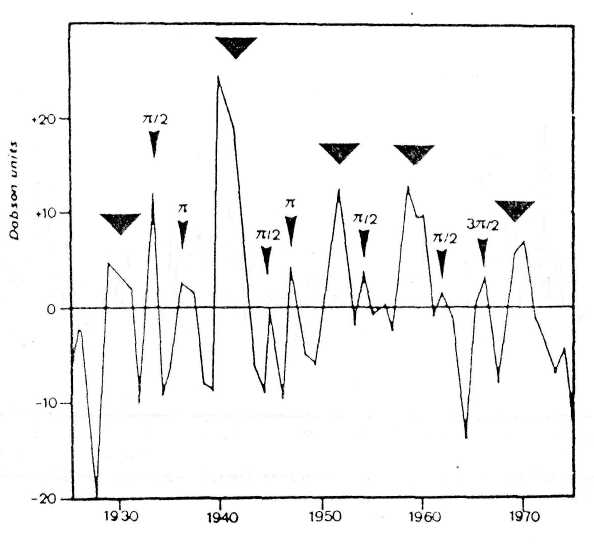
Solar-Terrestrial Cycles
Predictable Cycles in Geomagnetic Activity and Ozone Levels
by Theodor Landscheidt,
director of the Schroeter Institute for Research in Cycles of Solar ActivitySolar System. Constellations and Geomagnetic Disturbances
Geomagnetic storms, which are released by energetic solar eruptions, are important geophysical events. Newer results indicate that there is a connection with weather. Figure 1 shows the zonal type of atmospheric circulation as a result of geomagnetic disturbances caused by the sun's erup-tional activity, and meridional circulation related to a lull in geomagnetic activity. This is a permanent feature that regulates the prevalence of warm westerly flow or cool arctic air over Europe and North America. Statistical analysis covering the years 1955 to 1974 yields a correlation coefficient r = 0.65. Bucha (1983) attempted to give a geophysical explanation of this correlation.
The bulk flow speed of the solar wind, which is indicative of the energy of eruptional mass ejections and resultant shock waves caused by solar eruptions, is strongly coupled to geomagnetic activity, which in turn seems to be the common factor of a wide variety of terrestrial phenomena. Many authors — including Sazonov (1965), Mustel (1966), Beynon and Winstan-ley (1969), Stolov and Shapiro (1974), and Sidorenkov (1974) —have reported various connections between geomagnetic disturbances and fea tures of the troposphere. Cobb (1967) exhibited that the monthly variation of the air-earth current from mean values at Mauna Loa, Hawaii, is correlated with Bartcl's magnetic character index Cp.

FIG. 1. Above: Zonal type of atmospheric circulation, parallel to the equator, as a result of geomagnetic disturbances caused by tlie sun's eruptional activity. Below. Meridional circulation related to a lull in geomagnetic activity. Tlie Kp-scale (center) measures tlie degree of geomagnetic activity. After Buclia (1983).
According to Mustel (1977), surface pressure increases in anticyclones and decreases in cyclones after isolated geomagnetic storms. King (1974) reported similar results. In a study that covers the years 1964 to 1971, Roberts and Olson (1973) found that troughs that enter the Gulf of Alaska —or are formed there two to four days after a sharp increase in geomagnetic activity —tend to be larger than average size.
Prohaska and Willett (1983) applied Eigen-analysis technique to a matrix of cross-correlation coefficients between the geomagnetic aa-index and the monthly mean temperature at 32 U.S. stations, and isolated temperature anomaly patterns that are highly correlated with the aa-index. As this index is considered to be a strong descriptor of the solar wind, these authors hold that the source of the effect influencing the local temperature field through the atmospheric circulation is also driving the solar wind and disturbing the geomagnetic field.
Sazonov (1974) and King have drawn attention to the similarity between meteorological and geomagnetic contour maps. Neubauer (1983) discovered that sudden commencements of geomagnetic storms, released by solar eruptions, are related to displacements in the 70mb polar vortex in the lower stratosphere, which in turn influence the polar vortex in the troposphere.
Several of the major physical forces on the earth may be interrelated.
The shift in the 70mb polar vortex is caused by a localized sudden stratospheric warming. Of 66 magnetic storms observed during the winters 1978-79 and 1979-80, 61 were accompanied by such stratospheric warming. According to Neubauer, this effect can be explained in detail by geophysical processes. Furthermore, there are indications that explosive volcanic activity is related to changes in weather and climate. It is not out of the question that variations in the torque exerted by the solar wind on the earth's magnetosphere have an influence on volcanic activity by means of changes in the earth's rotational velocity and the motion of continental plates with respect to one another.
Some of these results may be spurious. Nevertheless, the link between geomagnetic storms and meteorological or geophysical responses is one of the few common threads that appear so widely in the otherwise disparate literature as to suggest that they probably have some validity. The Executive Committee of the International Working Group on Magnetic Field Satellites holds that there is an apparent relationship in the geomagnetic secular change to the length of the day and average global temperature on a decade time scale. This suggests that several of the major physical forces on the earth may be interrelated (EOS 1985). Thus, long-term prediction of geomagnetic activity seems to be important, both for space mission planning and for testing empirical understanding of the fast solar wind's impact on the earth's magneto-sphere and possible meteorological responses.
Long-range forecasts of geomagnetic activity were thought to be impossible, though there is a general correlation with the sunspot number R. In detail, however, the data do not correspond as well. This can be seen in Figure 2, which presents yearly means of the Mayaud-index aa that measures the observed geomagnetic activity. The data run from 1868 to 1984. Upward-pointing arrowheads mark the epochs of 11-year sunspot maxima. They do not match the highest peaks in the plot, and sometimes even coincide with minima —as, for instance, in 1979. The arrows pointing downwards, however, fit the most prominent peaks in geomagnetic activity in nearly all cases. They mark the epochs of strong impulses of the torque (IOT) in the sun's motion about the center of mass (CM) of the solar system. Strong IOT occur when the sun's center, CM, and Jupiter — the weighty center of the world of planets —are in line and form heliocentric conjunctions of Jupiter and CM.

It has been shown that such constellations are boundary phenomena that release instability in the sun's surface, together with a wealth of new patterns in activity that release corresponding effects in the earth's surface region. These terrestrial responses include variations in length of day, earthquakes, geomagnetic storms, ozone depletion, droughts and floods, rainfall, temperature, rise and fall in animal populations, economic turning points, interest rates, stock prices, variations in gross national products, periods of general instability, and human creativity (Landscheidt 1987, 1988, 1989a).
IOT events form cycles with a mean period of 9.275 years. Intriguingly, this period falls within the range of cycles clustered between 9.2 and 9.6 years and which comprise about 60 rhythms catalogued by E.R. Dewey. The double period of 18.55 years coincides with the lunar cycle of 18.6 years, thus complicating analysis of the causative background of different time series subject to such cycles.
A new peak in geomagnetic activity is to be expected around the next conjunction in 1990.3.
The relationship displayed in Figure 2 between Jupiter conjunctions with the CM and peaks in geomagnetic activity exemplifies the strong effect of IOT events. There were only two striking exceptions to the fit: the conjunctions in 1901 and in 1912. But these exceptions coincided with deep protracted 11-year sunspot minima; there was no potential of activity to draw on, as there were no, or only very few, sunspots that store magnetic energy which can be tapped by solar eruptions. No other such coincidence occurred in the investigated period.
The deficit in conjunction effects seems to have depressed the general level of activity in the decades from 1900 to 1920; it reached the deepest point in the period of observation of more than a hundred years. In 1967 and 1970, the related peaks were low. This could be due to a disturbance of the rhythm in the pattern. The interval between the two IOT events was unusually short, only 2.2 years. The depression in geomagnetic activity, however, could also be a special expression of the major solar instability event in 1968. The character of such events has been explained elsewhere (Landscheidt 1989 b).
A Pearson test of the goodness of fit of outstanding aa peaks, going beyond defined thresholds, and JU-CM-CS epochs, yields the value 17.1 for 1 degree of freedom (P = 0.00004). The strong enhancement of geomagnetic activity in 1982 was forecast with regard to these results in January 1982. The prediction was controlled by the astronomers W. Gleissberg, J. Pfleiderer, and H. Woehl.

A new peak in geomagnetic activity is to be expected around the next conjunction in 1990.3. A corresponding forecast was published (Landscheidt 1989a, p. 63). In January 1988, when the manuscript was conveyed to the editor, the geomagnetic activity was still in a lull. Meanwhile, the level of activity has dramatically changed. Figure 3 shows that the prediction is coming true. The triangle on the right points to the new peak in the making.
Jupiter, Center of Mass, and the Ozone Column
An abundance of papers speculate about the response of atmospheric ozone to solar activity and its effects on tropospheric climate. Reiter (1983) has launched series of radiosonde flights immediately after energetic solar flares. These observations revealed lowering of the tropopause, intrusion of warm stratospheric air from higher levels, formation of a sharply defined secondary ozone maximum immediately above the tropopause, perforation of the tropopause, emergence of jet streams, and change from zonal to meridional circulation. This development, involving ozone profile, was observed to occur within a few days after energetic flares. In-triguingly, Jupiter conjunctions with the CM also seem to be related to variations in the ozxine concentration.
Modern U.S. and Canadian records of such data extend back to only about 1960. But continuous ozone monitoring since 1926 at Arosa in the Swiss Alps provides a rare long-term record of ozone levels. Figure 4 presents the deviation of annual mean values from the 50-year mean of 337 Dobson units. A change of about 17 Dobson units corresponds to a 5% change in ozone concentration. The epochs of JU-CM conjunctions are marked by flat triangles. In the case of the events at 1967.8 and 1970, which are separated by an interval of only 2.2 years, the mean of both epochs is indicated. The epochs of the conjunctions fit the strongest ozone deviations. In addition, the phases n and tt/2 radians —the second and fourth harmonics of cycles formed by consecutive JU-CM conjunctions — concur with secondary peaks. Small arrowheads point to these phases.

FIG. 4. Arosa record of ozone levels since 1926. Tlie curve plots the deviation of annual mean values from the SO-year mean of 337 Dobson units. Triangles mark epochs of JU-CM-CS events. Arrowheads point to fiarmonics of cycles formed by consecutive Jupiter-CM conjunctions. The respective epochs meet peaks in the ozone column. After H.U. Duetsch.
After the major solar instability event starting in 1968, the pattern seemed to have changed. The epoch of JU-CM-CS in 1974 coincided with a minimum. According to forecast (Landscheidt 1989a, p. 66), the next minimum is to be expected in 1990.3 if the new pattern proves to be stable. Meanwhile, depletion of the ozone column has become obvious. The extrapolation of the pattern, however, points to a rising ozone column in the coming years and a maximum around 1994.4, the epoch of the second harmonic of the Jupiter-CM cycle.
References cited
Beynon, W.J.G.; Winstanley, E.H., 1969. Geomagnetic Disturbance and the Troposphere. Nature 222:1262-1263.
Bucha, V., 1983. Direct Relations between Solar Activity and Atmospheric Circulation: Its Effect on Changes of Weather and Climate. Studia Geoph. a Geod 27:1945.
Cobb, W.Ii., 1967. Evidence of Solar Influence on the Atmosphere: Electric Elements at Mauna Loa Observatory. Mon. Weather Rev. 95:905-911. EOS, 1985. Transactions, American Geophysical Union, p.441.
King, J.W., 1974. Weather and the Earth's Magnetic Field. Nature 247:131-134.
Landscheidt, T., 1987. Long-range Forecasts of Solar Cycles and Climatic Change. In Ram-pino, Sanders, Newman, and Koenigsson, editors. Climate, History, Periodicity, and Predictability. Van Nostrand Reinhold, New York; 421-445.
Landscheidt, T., 1988. Solar Rotation, Impulses of the Torque in the Sun's Motion, and Climatic Variation, Clim. Change 12:265-295.
Landscheidt, T., 1989a. Sun-Earth-Man: A Mesh of Cosmic Oscillations. Urania, London.
Landscheidt, T., 19896. Creative Functions of Cycles. Cycles 40:133-138 (May/June).
Mayaud, P.N., 1973. A Hundred-year Series of Geomagnetic Data, 1868-1967. IAGA Bulletin No. 33. IUGG Publication Office, Paris.
Mayaud, P.N.; Romana, A., 1977. Supplementary Geomagnetic Data, 1957-1975, IAGA Bulletin No. 39. IUGG Pub. Office, Paris.
Mustel, E.R., 1966. The Influence of Solar Activity on the Troposphere in the Polar Cap Regions. Soviet Astronomy - AJ 10:288-294.
Mustel, ER, 1977. Solar Activity and the Troposphere. NTIS, Springfield, VA 22151. Translated from the Russian.
Neubauer, L., 1983. The Sun-Weather Connection: Sudden Stratospheric Warmings Correlated with Sudden Commencements and Solar Proton Events. In McCormac, B.M., ed. Weather and Climate Responses to Solar Variations. Colorado Associated University Press, Boulder, Colorado; 395-397.
Prohaska, J.T.; Willett, H.C., 1983. Dominant Modes of Relationships between U.S. Temperature and Geomagnetic Activity. In McCormac, B.M., ed. Weather and Climate Responses to Solar Variations. Colorado Associated University Press, Boulder, Colorado; 489-494.
Reiter, R., 1983. Modification of the Stratospheric Ozone Profile after Acute Solar Events. In McCormac, B.M., ed. Weather and Climate Responses to Solar Variations. Colorado Associated University Press, Boulder, Colorado: 95-116.
Roberts, W.; Olson. R.M., 1973. J. Attnos. ScL 30:135.
Sazonov, B.I., 1965. On the Solar-Troposphere Relation. Astron. Zhurnal 42:653-655.
Sazonov, B.I , 1974. Circulation in the Troposphere and Anomaly in the Terrestrial Magnetic Field. In Drodzdov and Vorob'eva (1974):35-42.
Sidorenkov, N.S., 1974. Solar Corpuscular Fluxes and Weather on Earth. Moscow Akademija Nauk, Priroda 3:14-23.
Solar-Geophysical Data, 1989. Prompt Reports 538:132. National Geophysical Data Center, Boulder, Coloiado.
Stolov, H.L.; Shapiro, R., 1974. Investigation of the Responses of the General Circulation at 700 mb to Solar Geomagnetic Disturbance./ Geophys. Res. 79:2161-2170.
Published on http://bourabai.narod.ru/ according permission of Frau Christiane Landscheidt
Когда тот или иной физик использует понятие "физический вакуум", он либо не понимает абсурдности этого термина, либо лукавит, являясь скрытым или явным приверженцем релятивистской идеологии.
Понять абсурдность этого понятия легче всего обратившись к истокам его возникновения. Рождено оно было Полем Дираком в 1930-х, когда стало ясно, что отрицание эфира в чистом виде, как это делал великий математик, но посредственный физик Анри Пуанкаре, уже нельзя. Слишком много фактов противоречит этому.
Для защиты релятивизма Поль Дирак ввел афизическое и алогичное понятие отрицательной энергии, а затем и существование "моря" двух компенсирующих друг друга энергий в вакууме - положительной и отрицательной, а также "моря" компенсирующих друг друга частиц - виртуальных (то есть кажущихся) электронов и позитронов в вакууме.
Однако такая постановка является внутренне противоречивой (виртуальные частицы ненаблюдаемы и их по произволу можно считать в одном случае отсутствующими, а в другом - присутствующими) и противоречащей релятивизму (то есть отрицанию эфира, так как при наличии таких частиц в вакууме релятивизм уже просто невозможен). Подробнее читайте в FAQ по эфирной физике.
|
|